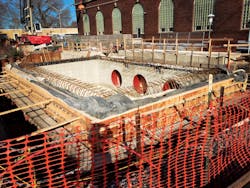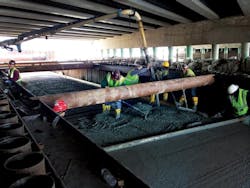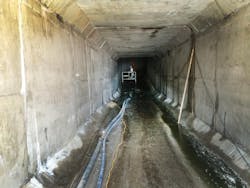Half & Half
To prevent sewer overflows, the Sanitary District of Hammond, Ind., installed new detention ponds in one of its wastewater treatment plants. It needed to build a new structure to serve those ponds.
“We’re building 1,700 ft of 11-ft-6-in.-by-10-ft-6-in. concrete box to bring combined storm and sanitary waste from existing culverts to the new ponds,” said Marty Zurbriggen, general manager for Ellas Construction Co. Inc.
MIC Prevention
The large expense could have been increased by a factor well-known to sewer network operators. Microbiologically induced corrosion (MIC) can destroy concrete sewers in a matter of months. MIC is caused by Thiobacillus bacteria, which consume hydrogen sulfide gas.
Hydrogen sulfide is a colorless gas that commonly produces the rotten egg odor associated with anaerobic digestion of organic matter. Sewers often present ideal conditions for hydrogen sulfide gas creation; the combination of warm turbulent water, low oxygen levels, and organic matter from sanitary and storm water flows leads to bacterial breakdown and rotten-smelling gas.
Hydrogen sulfide is poisonous, corrosive, flammable and explosive, but from the standpoint of sewer network operators, its worst quality is that it feeds and fosters huge colonies of Thiobacillus that consume the gas and excrete sulfuric acid. Some strains of Thiobacillus can thrive in acid concentrations as high as 7%. The acid attacks concrete and turns it into calcium sulfate, or gypsum.
Preventing MIC is hard, and can rule out the use of concrete sewers in some applications. There are no good ways to prevent gas buildup in most sewers, so operators have tried various external coatings. But coatings often fail, as even small gaps and holes can provide a foothold for Thiobacillus.
ConmicShield, from ConShield Technologies, prevents microbiological corrosion of concrete, making the concrete antimicrobial for as long as it is in use. It is not a coating; it is a liquid concrete admixture that permeates the concrete and makes it intrinsically inhospitable to microorganisms. Thiobacillus cannot find a foothold, so sulfuric acid is never formed.
Half of a Solution
“We knew this culvert would combine sewage and storm water in an low-oxygen environment,” said Dennis Benoit, P.E., senior associate for Hubbell, Roth & Clark Inc. “And we wanted to do everything we could to reduce the potential for MIC damage. ConmicShield is a great idea and there were reliable testimonials, so we specified it for this application.”
Using the product as an admixture for the entire 1,700-ft concrete sewer structure could have been prohibitively expensive. Benoit took advantage of the fact that the sewer would almost always be about half full, with seasonal flows only occasionally raising the water level over 6 ft. Because hydrogen sulfide and Thiobacillus cannot form under water, this meant that about half of the sewer did not need to be made with the treated concrete.
“It’s an ordinary job in most ways,” Zurbriggen said. “The regular concrete and the ConShield-enhanced concrete are the same texture and there’s no issue with bonding. So mainly it’s a matter of ordering the correct mix at the right time, and making sure we’re using the correct truck.”
Ellas Construction is building the culvert in 120-ft sections. First the base and footing are poured, then the wall is poured in strips that are 3 ft high. The elevation for the ConShield-enhanced concrete is marked on the plans, and Zurbriggen usually overlaps downward by 1 ft or so, to be sure all exposed concrete is protected against MIC.
Making sure the right concrete is used is not difficult, but it can be tedious; Zurbriggen has to monitor wall height, order concrete trucks with the right mix and double check the truck tickets prior to pour.
“On a typical day, we’ll go through 21 cu yd [of concrete] with ConmicShield, and 32 cu yd without,” said Paul Knueppel, senior project manager at Garcia Consulting Engineers. “It’s been relatively smooth—one of my main jobs is to check the ticket and be sure the right mix is being used.”
The concrete is prepared at Smith Ready Mix in Valparaiso, Ind. Sales Manager Scott Massom said mixing the admixture at short notice is not a problem.
“Our whole process is automated, so once the ConmicShield is mixed and stored in an admixture tank, it’s not a problem to make a batch at short notice,” he said. “We just select the tank, and it’s all standard procedure after that.”
Using antimicrobial concrete in just a portion of the concrete box reduced the cost of MIC prevention in this structure. The Sanitary District of Hammond gets concrete sewer infrastructure that is fully protected by antimicrobial technology, at a cost that is less than half of what it could have been.


